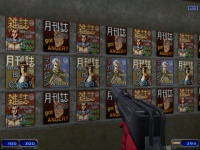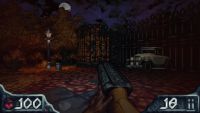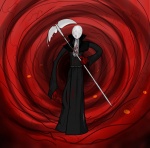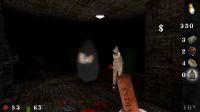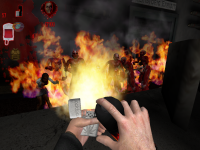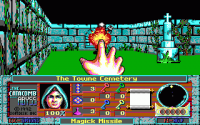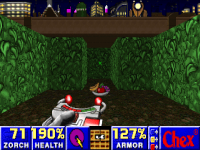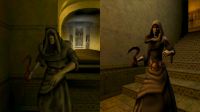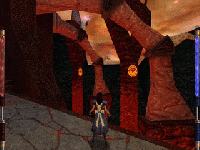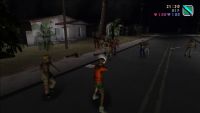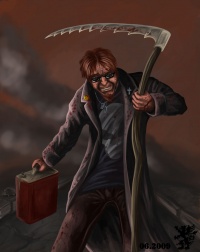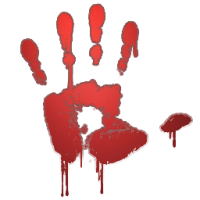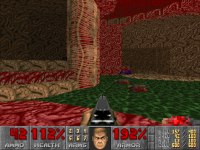Blood in Other Media
From Blood Wiki
Jump to navigationJump to searchThis is a list and index of outside media that have references to Blood or characters from that universe, or those that contain content similar to Blood.
References[edit]
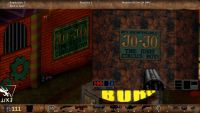
JoJo the Idiot Circus Boy Easter Egg reference in Postal REDUX
- In Shogo: Mobile Armour Division (a game developed by Monolith Productions congruent to the Blood II development) there are magazine covers that feature a picture of Caleb. Nearby the picture is Japanese characters followed by English text reading "Who is Caleb?". Fallen troops can also occasionally be heard exclaiming translatable Cultist phrases.
- Blood II: The Chosen was attacked by the February 2, 1999 comic of the then fledgling Penny Arcade, with character Tycho Brahe mocking the game's initial release bugs and slow patching process.
- Blood was listed among a set of other shooter games in the July 30, 1997 edition of the web comic >BYTE_ME.
- The Korean manhwa Priest is almost certainly inspired by Blood as it features an extremely Caleb like anti-hero protagonist and a supernatural dominated old west setting. The series creator Hyung Min-woo has gone as far as stating that the game and his comic are "inseparably related."
- FPS - First Person Shooter is a German independent film created by Gravelight Film which stars the voice of Stephan Weyte as the protagonist. Created as a tribute to the first-person shooter games of the 1990s as well as the horror films of the 1980s, it is filmed using a first person perspective similar to those present in the actual games.
- The first-person shooter Dusk is directly inspired by Blood, alongside other similar games such as Quake, Heretic, Hexen, Half-Life and fellow Build engine title Redneck Rampage. The game's developers are even known as New Blood Interactive, and the game has Stephan Weyte voicing Nyarlathotep, the game's final boss. Dusk features a fight with a cult including robed wearing acolytes, as well as mutant rats. Levels include sewers, steamworks, lumber yards, mines, churches, derelict towns, test chambers, research labs, crypts, tunnels wrought of flesh, and more. Horror Geek Life's Jason Lei Howden remarked that "DUSK is the answer to the question “what if Blood II was actually awesome?”"
- Another indie first-person shooter, Dread Templar (formerly Hell Hunt), is also inspired by Blood among other games such as the first Quake and non-shooters such as Bloodborne. Creator Johnny Blanchard remarked: "Another one is Blood, which I actually didn't like at all when I was a kid, even ranked it as one of my most hated FPS. But strangely enough, when I replayed Blood a few years ago I was totally hooked. Compared to other boomer shooters, Blood's level design is particularly fascinating to me, and DT is really inspired by Blood in level design."
- As clearly seen in Gmanlives' review, the indie first person shooter Viscerafest features numerous lines almost certainly inspired by Blood and Blood II.
- The retro first-person shooter Grim Pray features an art style and atmosphere based in part on Blood; The Disciples of the Full Moon from the same game jam has also been compared.
- The retro first-person shooter Coven features an atmosphere inspired by Blood and Heretic. Set in the witch-hunts of the 1600s, players also take the role of someone crawling out of a grave seeking bloody revenge, including consuming flesh as health and wielding akimbo flintlocks and a double barreled firearm.
- The first-person shooter Cultic is most directly inspired by Blood and is published by a revived 3D Realms label, the original of which spurred on development of the original game prior to 1997 when it was finally released by GT Interactive.
- In Ben "Yahtzee" Croshaw's Duke Nukem 3D Atomic Edition fan modification Age of Evil, the main character Chris Quinn paraphrases Caleb in the beginning of the second episode by saying "I live aga... Uh-huh. Sorry!" In Age of Evil there is also a level set on a train (E2M6: End of the Line) that is inspired by Blood, as can be inferred from the 1213 Special Edition commentary (a similar map exists called "Train in Veins" for another Duke Nukem 3D fan add-on entitled Metropolitan Mayhem). Chris like Caleb spends a short time undead, gets a sadistic pleasure from the death of his enemies and wears a black trench coat.
- Yahtzee also later referenced Blood, among other Build engine titles, as an example of what first person shooters should be in a Zero Punctuation review of Turok, as well as later pointing to Blood II: The Chosen (as well as SiN) as a typical "campy and colourful" shooter of the late 1990s in his "real" Duke Nukem Forever review. He finally reviewed Blood proper on June 26, 2019 following the release of Fresh Supply. He also refers to the famous E1M3: Phantom Express as a "good train level" in contrast to Medal of Honor: Above and Beyond, and refers back to Fresh Supply in his review of the System Shock remake by Nightdive Studios.
- He also cited the Plasma Pak as an example of a traditional expansion pack in a 2015 Extra Punctuation.
- The first game in the Arthur Yahtzee Trilogy also features the player making a rat burger, a concept mentioned in Blood.
- It has also been suggested that the design of Cabadath in the Chzo Mythos is inspired by the Zealot as seen in Blood II. Cabadath has in turn been cited as a possible influence on the design of Slender Man.
- The first game in the Arthur Yahtzee Trilogy also features the player making a rat burger, a concept mentioned in Blood.
- He also cited the Plasma Pak as an example of a traditional expansion pack in a 2015 Extra Punctuation.
- Yahtzee also later referenced Blood, among other Build engine titles, as an example of what first person shooters should be in a Zero Punctuation review of Turok, as well as later pointing to Blood II: The Chosen (as well as SiN) as a typical "campy and colourful" shooter of the late 1990s in his "real" Duke Nukem Forever review. He finally reviewed Blood proper on June 26, 2019 following the release of Fresh Supply. He also refers to the famous E1M3: Phantom Express as a "good train level" in contrast to Medal of Honor: Above and Beyond, and refers back to Fresh Supply in his review of the System Shock remake by Nightdive Studios.
- The Brogo Webcomic referenced Blood II: The Chosen on October 31, 2008, the game's tenth birthday. The comic features a Caleb jack-o-lantern and the Brogo character Michelle references a quip from Caleb by saying "It is getting to the point that I'm no mechanic, I just mostly hurt people". This quote is derived from a scene in "C3L4: Cabalco Enterprises", where Caleb encounters broken down elevators
- In the 2009 free software game Windys by Piga Software the text "Security to the Zombie Cage!" can be found in the secret level as a homage to E1M8: House of Horrors. Level 6's starting text reads "Sure smells dead around here" inspired by a recording from the Blood II REZ file and the Boss Level's starting text reads "That's him! That's the man you're looking for!" as a reference to C3L4: Cabalco Enterprises. The boss's ASCII depiction is replaced by "???" in the help form to hide his look until you win the game; this is inspired by Tchernobog's depiction on the Blood website.
- Notably, even though Blood contained many horrified urban settings such as shopping malls, carnivals, and train stations it never contained a full on restaurant level. Smaller sections include the track side "rat burger" grill in E1M2: Wrong Side of the Tracks, the dining car in E1M3: Phantom Express, the concession stands in E1M4: Dark Carnival and the "worm ridden filth" cafe in CP02: Old Opera House, among others, as well as a diner present in the Blood II level C2L5: Horlock's Station which serves "Cream of SumYungGai".
- Their 2021 release Hedged is set in a wintry 3D hedge maze inspired both by Blood and its original inspiration from The Shining; Bring Them On from the same year features monsters coming through portals and a remark that the protagonist would have foreseen the danger if he had paid attention to "any video game of the last thirty years" in reference to, among others, Doom, Quake, Blood II and Half-Life. The 2022 release Nightfall features a powerup shaped like a human heart that restores full health. The 2023 update adds in beast mode, which like envisioned with Blood transforms the player into a werewolf-like creature temporarily after getting enough kills. It also refers to it as changing into something unpleasant on the help screen. Enemies include bats, rats, zombies, spirits, gargoyles, and other ghouls.
- In "The Carnival" level of POSTAL Redux a sign can be seen from the original Blood promoting JoJo the Idiot Circus Boy.
- Infra Arcana, a free roguelike created by Martin Törnqvist, borrows heavily from Blood's entourage and gameplay, including cultists and their signature curses, self-reanimating zombies, tommy guns and dynamite (complete with agonized screaming of its unfortunate victims). The general feel of this game is reminiscent enough to consider Infra Arcana almost a roguelike version of Blood. The game also features quite a few references to Lovecraftian fiction, further establishing the resemblance.
- A recent original Half-Life modification called Half-Rats: Parasomnia makes an obvious nod to the aesthetics of Blood by offering a stylish Western horror setting of the 1800s. Half-Rats is actually a series of mods with independent stories focusing on the same character, who finds himself in all sorts of trouble usually involving the undead, madness and infernal entities. The main hero wears a black hat and a trenchcoat, and is often observed making intelligent, but cynical remarks, which clearly betray inspiration by the signature attributes of Caleb. In Parasomnia, there is a carnival level, although the player encounters highly aggressive clowns instead of the placid, passive mimes from Blood. The mod features an inventory system, with the player being able to find and buy restoratives (food) and ammo via vending interface. The weapons include a revolver, a carbine rifle, a sawn-off and even a gatling gun. Light is a limited resource represented by a lamp recharged with fuel. There are a few puzzles and boss battles along the way. A mid-game boss has a deep voice similar to The Voice/Tchernobog, albeit the conversation between him and the protagonist is more elaborate and humorous compared to the cutscenes in Blood.
- The Heaven nor Hell urban fantasy trilogy by Clinton A. Love, as well as subsequent books within that universe, features numerous nods that reference Blood, including cultists called Chosen and the "High Speech" used by demons and some vampires that contains phrases reminiscent of the ones the cultists scream in Blood.
- The Brutal Doom 64 mod uses modified Tchernobog sprites to add in the Revenant, which was not present in the original game due to cartridge restrictions.
Possibles[edit]
- The officially recognized Postal 2 total conversion Eternal Damnation contains a great deal of similarities to Blood such as zombies (with a similar head destruction requirement), Sawed-Off Shotguns, Dynamite sticks, Aerosol can flame-throwers, Submachine Guns, levels such as a carnival, subway train, apartments, hotels, subway station, museum, sewers, mall, stores, docks, mountains and cathedral. John Murray is arguably more like Caleb than the Postal Dude as he is more consciously violent rather then sarcastic; though he is surely more coarse in language then Caleb. The beginning of the game is set in a asylum and is thus also similar to the Blood fan add-on BloodLines. At least one weapon is actually stated to have been inspired by Blood, and known Bloodite Nicola "Neurological" Capecci was the game's musician.
- The video game Duke Nukem Forever features a number of lines that are similar to those in the Blood series, such as "time to paint the town red", "another day, another disembowelment", "rainin' blood, baby", and the Army of Darkness quote "good, bad, I'm the guy with the gun". The quip "when you get to hell, tell 'em Duke sent ya" is particularly curious as the taunt "when you get to hell tell 'em I sent ya, you'll get a group discount" was an original for Blood II submitted by Glen Maydom in a fan one-liner contest. The voicemails scattered throughout the game are also similar to the phone gags from Blood II. As another sequel to a Build engine title, opinions were similarly divided as with Blood II - only Blood II had notably higher scores on average and has been commonly described as rushed out, something Forever certainly was not. That said, the gold version did feature notable cuts restored by the Duke Nukem Forever: Enhanced mod similar to the tweak mods for Blood II; though unlike was the case with Monolith the tools were never officially released by Gearbox but later recovered.
- OpenArena, a free software arena first-person shooter game built on the ioquake3 engine, contains many Blood-like bots such as gargoyles and spiders (and a cultist-like bot called an "Assassin"). Also one of the original OpenArena developers has a user page on DeathMask (with the comment "Gargoyles are cute"). It is possible that these connections to Blood were deliberate. It is also worthwhile to note that the Q3 BloodBath maps and the Caleb Quake III bot/model both work in OpenArena.
- It was once suggested on the Left 4 Dead wiki that the Left 4 Dead 2 campaign "Dark Carnival" may be a reference to the map of the same name from Blood.
- The Marvel Comics character Shiver Man was once a man named Caleb Jackson who lived in the Wild West and killed armed men who had hidden in a church, because he was seeking revenge against them for killing his wife. During the fight, Caleb accidentally gunned down a priest in the crossfire just before he finished putting a curse on Caleb, stating that when Caleb died himself soon after, he would walk the Earth forever as some kind of restless undead creature for bringing violence into his church. Shiver Man's first appearance was in Wolverine #163 in June 2001, four years after Blood was released, while his true name was revealed in Astonishing Tales: Shiver Man #1 released in April 2009.
- They Hunger, a notorious horror mod for the original Half-Life released in three parts during the advent of the 2000s, is very similar stylistically to Blood. The story revolves around anonymous writer who visits a quiet, secluded town in hopes of getting some inspiration from the local environment. Instead he finds the place forlorn, defiled and completely overrun by a horde of its former residents, now reanimated and zombified. This mod strays far from the "metal military bunkers" style of early first-person shooters, in favour of plunging the player into an oppressive atmosphere of hopelessness and constant, yet uncertain fear. Locations include a swamp, occult Stonehenge-like site, mausoleum, catacombs, countryside (with zombified animals), church, various ruined buildings and an insane asylum. Much like Blood, They Hunger makes use of makeshift and vintage weapons like heavy brass umbrella and bundles of dynamite (which are far less common in this game). Unlike Blood, various vehicles are prominently used at certain stages. A deliberately minimalistic, dim and washed out graphical style (even for its time), challenging gameplay and genuinely disturbing voice acting are likely to pique the interest of many Blood fans seeking another dose of intense, purely dark gaming experience.
Coincidences[edit]
Pre[edit]
These games pre-date Blood, and therefore can be safely said to be, at best, inspirations for the game; see also, Doom
- The early first-person shooter Catacomb 3D, and especially its Adventure Series sequels, feature several stylistic similarities to the later Blood series, including similarly dingy textures, using magical weapons against monsters, robe-wearing mages, semi-visible entities, bats and zombies (although conventional firearms are not present for the player; the final game has skeletons armed with Gatling guns and robots armed with lasers), zombies rising from the ground (and walls), entities converting from stone, and levels including crypts, hedge mazes and gardens, dark forests, mines, temples, infested towns, monster holding areas/testing grounds, insect colonies (ants rather than arachnids), lava areas, dungeons and even sewer and aqueduct levels (with monsters that swim). Nemesis and Tchernobog share a similar skeletal appearance. The games are more dark fantasy as opposed to gothic horror, but the final Catacomb game, Apocalypse, shares some of the dark science fiction styling of Blood II: The Chosen. Following the source code being released in 2014, support was added to the ReflectionHLE as well as the CatacombGL project.
- The Catacomb sequels were designed by Greg Malone, later creative director for Duke Nukem 3D as well as Brian Goble's Nuclear Nightmare prototype, which might explain some of the stylistic similarities; he also worked briefly on fellow Build engine stable-mate Shadow Warrior (which shared a sense of humour about rabbits). The games were also principally created by the founders of JAM Productions, developers of Blake Stone.
- The 1993 first-person shooter Ken's Labyrinth features a couple different enemies similar to Blood, including spiders, bats, and cloaked ghosts. As Ken Silverman's first 3D game, it is also a forerunner to the Build engine. As with the Build engine, the game in 1999 and its source code in 2001 was released as freeware, leading to ports such as LAB3D/SDL, including a hires version.
- The 1993 first-person shooter/graphical adventure game hybrid Isle of the Dead takes its cues from campy B movies, featuring zombies rising from the ground, a fat zombie, vampire bats, evil canids, and a mad scientist. One zombie features a severed head, but remains very much mobile, as well as plenty of other gore (with some censorship later present in the CD-ROM version).
- The 1993 first-person shooter Freaks! features an amoral protagonist who is resurrected by the goddess Gaia after being betrayed and killed by his scheming apprentice, reconstituting himself from his fallen foes. The game, developed by a Spanish development team lead by Ángel Ortega known as Lovecraft Dreams, features a number of gothic horror and dark fantasy themes. Enemies are varied, including bats, gargoyles, robed cultists, zombies, phantoms and more. Locations visited include tombs, crypts, dungeons, graveyards, forests, gardens. cathedrals, temples, libraries and laboratories. The original MS DOS version restricted the player turns to only ninety degrees, similar to grid-based dungeon crawlers, but a re-write was released in 2002 for Windows and Linux that added in free turning among a number of new environmental effects, as well as making health boosts granted after consuming corpses rather than upon killing opponents. The game was also released into the public domain.
- The 1994 first-person shooter Nitemare 3D was, like Blood, inspired by classic horror franchises. As such, it shares several similar enemies such as bats, werewolves, and the undead, and also features a combination of firearms and magical weapons. The game is mostly set in a haunted house, similar to levels such as E2M5: The Haunting. The main antagonist is also a mad scientist named Dr. Hammerstein. Unlike Blood however, the game features no explicit gore. In addition to the MS DOS incarnation, a version was also released for Windows 3.1.
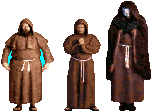
Robed enemies from the original Rise of the Triad
- The 1994-5 first-person shooter Rise of the Triad features the player fighting an evil cult, although with more a fascist militaristic edge than the Cabal (from its initial conception as a Wolfenstein 3D expansion). Robbed opponents begin showing up in episode four, with Death Monks and Death Fire Monks, as well as the game's ultimate boss El Oscuro. The entire game is based on the premise of a special forces team called HUNT infiltrating a captured monastery on the island of San Nicholas. The last episode also makes a magical staff weapon available to the player. Although tongue-in-cheek, the game's Dog Mode is not dissimilar in concept to the Beast mode originally conceived for Blood; as well as the option of selecting multiple player characters which eventually was added in Blood II: The Chosen. The Blood Alpha contained gas mask and asbestos suit items similar to those found in ROTT.
- The game also premièred many features present in Blood, such as destructible objects, bullet holes, varying forms of armour, a variety of environmental traps (including flung fireballs), the use of push walls as essential game elements (foreshadowing the dynamic sectors present in Blood), using player translation to avoid engine limitations (elevators in ROTT, room-over-room/underwater in Blood) and heaping doses of graphic violence, and is often considered a dry-run for then in-development Build engine games. ROTT was instead the last title to use the Wolfenstein 3D engine, heavily modified by Blood contributor Mark Dochterman, which included the use of pixel shearing to simulate looking on the vertical axis used in Build, as well as some shared code from the early Doom engine. The game's source code was released in 2002, leading to source ports such as icculus ROTT, WinROTT, NakedTriad and rottexpr. This title has also received a modern, and very loyal, remake built on Unreal Engine 3 by Interceptor Entertainment (now Slipgate Ironworks, part of the Saber Interactive); one contributor to which was later involved in the Blood Evolution fan project on Unreal Engine 4, while Interceptor itself is receptive to making a commercial remake should the rights ever land their way. A remaster by Fresh Supply developer Nightdive Studios was also published in 2023 by a revived Apogee Entertainment entitled Rise of the Triad - Ludicrous Edition using the Kex Engine.
- Deadlands is a genre-mixing alternate history role-playing game which combines the Western and horror genres, with some steampunk elements. The original game was written by Shane Lacy Hensley and published by Pinnacle Entertainment Group in 1996.
- The first-person shooter Killing Time features numerous stylistic and gameplay similarities to Blood. Its arsenal includes akimbo pistols, shotgun, and a tommy gun (as well as using a crowbar as a melee weapon before Half-Life); molotov cocktails function similar to dynamite. Enemies include various types of zombie, including butcher knife throwing chefs, and even two-head dogs. The Windows/Mac version also features a hedge-maze, among many other similar environments in and around Tess Conway's island mansion. However, it needs to be noted that the PC version was released in 1996, one year before Blood - and the original 3DO incarnation was released a year before that in 1995 - meaning it is only possible for it to have inspired Blood, and not the other way around. The game also took the then-popular full motion video route for its cutscenes, while Blood used the competing format of pre-rendered 3D cutscenes. In 2024 a remaster was announced by Fresh Supply developer Nightdive Studios entitled Killing Time - Resurrected using the Kex Engine.
- Strife features some Gothic elements similar to Blood due to its futuristic medieval aesthetic, with its story also being based around fighting an evil cult. As well as the ubiquitous sewer level, Strife also features catacombs, temples, laboratories, and mines. The player can set both enemies and himself on fire, and the game's Sigil weapon will drain your health for ammunition much like the Life Leech does once it runs out of Trapped Souls. Released for retail on May 31, 1996, it was published exactly one year before the full North American release of Blood. Its current re-distributor, Night Dive Studios, released a modern remaster of Blood on May 9, 2019 as Blood: Fresh Supply.
- Despite being a Doom total conversion, the advertising video game Chex Quest (and sequel episodes) features many Build engine styled sensibilities in how it presents more realistic environments. Chiefly like Duke Nukem 3D (featuring vent passages and even a theatre level), the level most like Blood is E1M3: Chex Museum from Chex Quest 2 which features environs similar to "C1L3: Lafayette Museum of Antiquities" and later a hedge maze ala "E2M3: Rest for the Wicked" or "C5L1: Cold, Cold Grave". E1M4: City Streets of Chex Quest 2 or E3M3: Villa Chex of Chex Quest 3 also reminds of E3M1: Ghost Town or the environs of New Town. E3M2: United Cereals of Chex Quest 3 features a subway train similar to those repeatedly seen in Blood II. E1M3: Laboratory of the first Chex Quest is similar to "C3L7: Research and Development", with flasks and equipment resting on tables. As with E3M3: Raw Sewage, Chex Quest 2 features its own take on the classic sewer level trope with E1M5: Sewers. E3M4: Provincial Park of Chex Quest 3 features mountainous terrain similar to "E5M7: Mountain Pass" or "E4M6: The Ganglion Depths". It should be noted that Chex Quest 3 was first put out in 2008, and so might feature some direct inspiration from Blood; the first two were released in 1996 and 1997 respectively and so are contemporary to the game's development.
- The 1995 first-person shooter Gloom features a Gothic theme in its second episode (the preceding science fiction, the following hellish), including bipedal monsters that rush the player, dark hooded ghouls, large teethed demons, and most notably cloak wearing translucent floating spectres. The game was ported to systems other than its original Amiga in 2020 via the ZGloom source port, following the game and engine code being released in 2017.
- The fellow Build engine game PowerSlave (aka Exhumed) was also started under the patronage of 3D Realms under the title "Ruins: Return of the Gods" by another Washington state based developer, Lobotomy Software, before like Blood later being published elsewhere in 1996 and 1997 after splitting with them on November 8, 1995. They even shared artist Eric Klokstad. This project's mythological themes (albeit ultimately alien in nature) also dissuaded Nick Newhard from adopting a fantasy theme for what became Blood (which was also present in Witchaven, the first released Build game in 1995), switching instead to gothic motifs as "Horror 3D". Similarly to Blood, plans were made for ports to the Sega Saturn and Sony PlayStation, but unlike with Blood these actually came to fruition. Actually first releasing before the DOS version on the Saturn, these use Lobotomy's in-house SlaveDriver engine and vary considerably from the Build engine incarnation in level structure and gameplay, taking on traits of a Metroidvania. It was these versions that later inspired the Kex Engine based Nightdive Studios remaster PowerSlave Exhumed, previously PowerSlave EX, who also released Fresh Supply. The DOS version however is supported by BuildGDX, the NBlood adjacent PCExhumed, and the Raze source port (the first and last of which add in-level saving alongside the original checkpoint system), with both versions available separately from GOG.com and Steam.
- The DOS version shares some of the tendencies of its Build engine contemporaries, although less pronounced. The game's protagonist only occasionally speaks (voice acting more prominently featured from Rameses), and although supported by the executable no slopes are present, which along with less evocative and more abstract settings exudes a Doom style level design, albeit still with more verticality and even platforming. Spider/beetle-like enemies called Terrainians feature in the DOS and Saturn versions, replaced by scorpions on PlayStation (with both in the remaster), with spider webs and nests present in levels such as Abydos; the second boss Selkis spawns a number after death, implying a relation to them similar to that of Shial. Am-Mit functions similarly to Cerberus minus the fireballs. The Omen Wasps fly erratically similar to Gargoyles; a bunch of juvenile wasps are also released by the Kilmaatkhan upon death. While Blood lacks a conventional pistol, PowerSlave instead lacks a shotgun, sharing a sharpened garden tool, machine gun, thrown explosives, magical staff, and cursed talismans. PowerSlave has a flamethrower that sets people on fire, and the player themselves can be set alight by lava. The game features Bone Eel-like Piranhas, though unlike other Build engine titles, the player cannot use firearms underwater (although Blood does restrict use of fire based weapons while submerged) and, while a scuba-like Sobek mask is also present, submerged oxygen deposits can also be found. The inventory is further filled out with the expected invulnerability, health restoration (also as a human heart), a torch, and double damage powerups; while still triggered on demand, they require collected magic power to use (on console the Sandals of Inkumper artifact is similar to the Jump Boots from Blood, with the Horus Feather similar to the cancelled "raven flight" powerup). As an inversion of the beast mode that was supposed to feature in Blood after killing enemies, the mummies in PowerSlave can turn the player temporarily into one of them, arming them with a powerful one shot attack. The game was not shipped with a level editor, although the version from William Shatner's TekWar was mostly compatible, leading to the fan add-on Return to Ruins posted on Duke4.
- Duke Nukem 3D from 1996 popularized many conventions, extended from Doom, present in its later Build engine stablemate Blood, most notably a talking protagonist, quirky weaponry, pop culture references, underwater combat sections, jumping and platforming, realistic locations, and destructive and interactive objects and environments. Many of these features made their way into Blood at the insistence of Duke designer George Broussard, even if the relationship between Monolith and 3D Realms ultimately broke down. Shadow Warrior continued developing these ideas, releasing just months after Blood in the summer of 1997, and in addition shared room-over-room and voxel enhancements, but also added usable turrets and drivable vehicles. Similar influences are exuded in various successors, as delineated below, such as SiN, Prey, Duke Nukem Forever, as well as Ion and Phantom Fury.
Post[edit]
These games were released around or after the release of Blood or Blood II, and therefore might not actually all be coincidental.
- Two games named Blood and Blood 2: Back to Brutality were released by Arts of Darkness in 2000 and 2003, respectively, for Commodore 64 computer and its emulators. Apart from the name of the dilogy and its over-the-top violent nature (such as the detailed dismemberment / headshots), there appears to be no further similarity with Monolith's Blood franchise whatsoever.
- Redneck Rampage, another Build engine title released adjacently to the original Blood, also has a level set in a mortuary similar to E1M1: Cradle to Grave and even hides a health boost inside the crematorium. The level ends with the player descending into a grave, rather than starting by rising out of one however. The mausoleum lying beneath is also similar to E3M8: Catacombs, and it even features a small hedge maze ala E2M3: Rest for the Wicked. This is further revisited in the mansion level in the second episode, feeling very similar to a summer E2M4: The Overlooked Hotel. The second level of the game, Lumberland, is of course reminiscent of E2M2: The Lumber Mill. The J.Clucks level is also similar to C2L4: Cabalco Meat Packing Plant from Blood II. Downtown Hickston is somewhat similar to E3M1: Ghost Town, while the Uranium Mines are similar to E2M7: Bowels of the Earth. As with many shooters of the era, both Blood and Redneck Rampage feature a sewer level. The games also share sawed-off shotguns and dynamite, although they are more sophisticated in Blood. The alien vixens phase in and out similar to Phantasms. Billy Ray Jeter clones act like less agile Cultists, while Sheriff Hobbes is similar to Fanatics, the Doberman Dogs are swift like Hell Hounds and Mosquitoes are nuisances like Bats. The game is supported by the BuildGDX source port, as well as the Rednukem port by the developer of NBlood.
- SiN features rats that attack the player much like in Blood. In one level of the game protagonist John Blade is also turned into a mutant, which plays much like the planned Beast Mode from the Blood development. Sharing a similar near future setting, the game also has many similarities to Blood II, including levels set in subways, laboratories, sewers, water treatment plants, and corporate offices. Amusingly, the game came out on the very same day as the demo for Blood II.
- Wages of Sin includes many of the same urban locales including a level set in a museum. It also depicts a sect of mutants led by a Robed Cultist.
- Half-Life: Opposing Force features two chapters (Crush Depth and Vicarious Reality) that are very reminiscent of "C3L7: Research and Development" right down to featuring terrariums housing otherwordly creatures and otherwise caged laboratory specimens, as well as advanced weapons research. It should be noted that the expansion to the original Half-Life was released in April 1999, meaning it was under development in the months immediately following the release of Blood II.
- Both Quake III Arena and the Unreal Tournament series feature a low booming announcer voice that provides commentary to the action on screen, similar to The Voice from Bloodbath. This is also apparent in many other later games, including the speedrunning platformer SEUM: Speedrunners from Hell which even features a similar chiding sarcasm for the player's failures as well as acknowledgement of their triumphs.
- Vampire: the Masquerade - Redemption by Nihilistic Software is a gothic-themed action role-playing game that was released in 2000. Unlike the better recognized and well-known game Bloodlines by Troika Games, Redemption features a gothic storyline involving both the Dark Ages and the present time, with levels ranging from middle-ages towns, chapels, monasteries, cathedrals, castles and strongholds to urban areas like warehouses, offices and sewers. There are both ancient (pitchfork included!) and modern weapons, as well as occult items and powers to gain. Despite being a Vampire: The Masquerade game, there's plenty of other types of undead enemies in Redemption, including zombus (sic). The robed Cappadocians in one early quest are also resembling Cabal Cultists a lot (although they do not use firearms). Visually it is often quite reminiscent of Blood, but some elements, like the black humour, are more rare in Redemption. There's a whole party of characters for you to control, with the maximum of four members. The main character shares with Caleb his fate of undeath and having to feed on Life Essence/Vitae (human blood), though in this game (as well as in Bloodlines) there is a deeper emphasis on your undead nature.
- Vampire: The Masquerade - Bloodlines, released by Troika Games in 2004, is situated entirely in the neo-gothic urban setting featuring an intricate, complex plot revolving around a vampire fledgling caught in the middle of a conflict between the undead society's many factions. The levels in Bloodlines include a haunted hotel reminiscent of The Shining, city hubs, hospitals, graveyards - mixing typical city environments with traditional horror settings that can also be found in Blood levels. The game's grim, cynical atmosphere and liberal use of black humour are quite similar to Blood, though being a role playing game, Bloodlines includes more gameplay elements other than shooting and solving puzzles. Both Bloodlines and Redemption have levels where the architecture is made of flesh.
- Although conceptually distinct, the action role-playing game Deus Ex does bear some artistic similarities to the Blood series, most importantly due to it's gruff voiced trench coated protagonist and it's emphasis on dark urban environments similar to much of Blood II: The Chosen. Both games place a heavy emphasis on subway systems, and Deus Ex does have two sequences taking place in a crypt and one in a cathedral.
- Max Payne (2001) by Remedy Entertainment also has a few things in common with Blood: the general noir style prevalent throughout the whole story, a gloomy protagonist suffering from loss of the loved ones and seeking revenge. Max wears a trenchcoat, and combat often happens in desolate urban areas. Many locations in the game are covered with snow, and the action happens during the night-time - which invokes certain similarities with the second episode of Blood. The psychedelic dream sequences include Max walking on the trails of blood, suspended in a black void. A more direct similarity is in the games' conception, as both were started as projects supported by 3D Realms.
- In a similar vein with the previous title, The Punisher (2004) is another gruesome third-person shooter with a long-coated, perpetually grim protagonist on a vigilante crusade against the murderers of his family. Frank Castle's coarse voice and cold remarks can instantly remind players of Caleb. The game's dark urban (and occasionally cyberpunk) style and extreme violence including a whole plethora of execution and torture sequences make The Punisher a worthy spiritual successor to Blood.
- American McGee's Alice (2000), a third-person horror game includes prominent use of gory combat, haunting soundtrack and twisted grotesque environments. Constructions similar to the Blood "In The Flesh" map appear in the late stages of the game, while the weapons and early levels in Alice are quite similar to the playful dark humour of the carnival level from Blood.
- A 2003 horror shooter game, Nosferatu: The Wrath of Malachi involves a journey into a vampire count's castle, where the main hero, James Patterson, is trying to save his sister and other relatives from a marriage celebration gone terribly wrong. The presence of vintage flintlock pistols, cane sword, muskets, revolvers and holy water, together with enemies including lesser and greater vampires of both genders, ghouls and zombies, makes this game a staple of the early horror first-person shooter genre, just like Blood. The gothic architecture of the Count's castle is similar to some levels present in the first Blood, but is unusual in that it is generated randomly on each new playthrough - coupled with a time limit imposed on the player during the rescue of his family, this makes the gameplay quite a challenge.
- The 2005 console first-person shooter Darkwatch features a similar weird western horror setting to Blood, and a maniacal hat-wearing protagonist with a thirst for blood. Darkwatch has been cited as an influence on the 2022 third-person shooter Evil West by modern Shadow Warrior developer Flying Wild Hog.
- Sacred, a 2004 Action RPG by Ascaron Entertainment, includes robed cultists called Sakkara Priests among the commonly encountered enemies. These fanatics cast magic spells, practise demon worship (e.g. human sacrifice, summoning infernal entities) and utter various curses when approached by the player character.
- Call of Cthulhu: Dark Corners of the Earth (2005), akin to Blood, makes many references to the Lovecraftian horror fiction. The humanoid fish monsters play a major part in the game, although they are more closely tied with H. P. Lovecraft's original concept of The Deep Ones. Most levels of Call of Cthulhu happen at cold autumn/winter night or underground, with player being heavily overpowered by a multitude of monsters. It also shares with Blood its themes of insanity, wickedness and vicious cults. Plus, there is a Tommy Gun with the drum magazine!
- Clive Barker's Undying (2001) is a first-person shooter horror game focusing on topics of the occult, curses and corruption. The player can utilize the power of magic in addition to conventional weapons. In Undying, spells are used directly or with an optional aid of a magickal stone, while Caleb uses magic via talismans. The game has rather extensive graphic violence and gory after-death sequences mocking or scaring the player. Locations to be visited include a mansion, a crypt and a monastery.
- GTA: Long Night, a 2005 total conversion modification by The Fighting Hellfish for Grand Theft Auto: Vice City, features a very atmospheric urban zombie horror setting. Following the original game's story, defeated antagonist and drug baron Ricardo Diaz returns from the grave as a zombie to kill and take back his criminal empire from Tommy Vercetti, former protagonist of Vice City. Diaz's revenge rouses hordes of other undead citizens that quickly wipe out nearly all of Vice City's current population, leaving only a small group of survivors who manage to take temporary refuge in a movie studio. Long Night is notable and memorable for its non-linear narrative consisting of both flashbacks and present time missions from various playable survivor characters, who face unique and extreme challenges in what has now become a Zombie City. In stark contrast to the original, all action happens at near pitch-black midnight devoid of normal cars and pedestrians typical of any GTA game. It definitely shares with Blood its oppressive atmosphere of loneliness and hopelessness. Long Night's zombies are capable of running at full speed and attack the player ceaselessly in constantly respawning hordes, making for much more hardcore gameplay than base game. Thankfully, the mod's rendition of Sawed-Off Shotgun is exceedingly powerful, downing several enemies per shot.
- The first-person shooter video game Soldier of Fortune contains one level set on a train similar to that found in E1M3: Phantom Express. The opening subway level is also reminiscent of several levels found in Blood II. It also includes a "Microwave Pulse Gun" which is broadly similar to the Tesla Cannon. The GHOUL engine that powers the game's "gore zones" provides similar features to those supplied by the Limbloss modification for Blood II by Andy Guillaume.
- In Return to Castle Wolfenstein, upon being raised from his 1000-year imprisonment, Heinrich I exclaims "I live again!" RTCW contains a Tesla Gun that is quite similar to the Tesla Cannon from Blood as well as Dynamite and a Thompson Submachine Gun (albeit more military inspired than the classic gangland-derived weapon of Blood). Also, Deathshead's Super Soldier laboratory has been described as similar to "C1L6: Center for Disease Management". Many of these similarities probably come from RTCW being set only 15 years after Blood.
- Postal 2 features a wide variety of similarities to Blood and Blood II such as a talkative anti-heroic trench-coated protagonist (though more morally ambiguous than downright evil), an implementation of head kicking, similar urban environments to Blood II including a meat factory and water filtration plants, and interactions with non-playable characters similar to that of Innocents. Both games feature deliberately over the top violence but Postal 2 also features obscenity, stereotypes, and other shock-value functions as well as subtle (and not so subtle) social commentary. Reviews and user comments of the game also have compared the Postal Dude's numerous quips to those of Caleb.
- The Postal 2 expansion Apocalypse Weekend also features some similarities to the Blood series such as the introduction of zombies which can have their heads removed (though unlike Axe Zombies, they will continue to move and attack the player unless the head is actually destroyed) and hospital levels exhibiting some of the dark tones of E3M4: The Sick Ward, or the Blood II fan map Hospital of Souls, as well as a bridge level. It also for the first time allowed the player to dismember bodies, a feature similar to that provided by the Limbloss modification for Blood II by Andy Guillaume.
- Several weapons and elements from both the Eternal Damnation (see above) and the A Week in Paradise fan modifications have made their way into the main product as updates, bringing the original game even closer to Blood.
- The Postal 2 DLC Paradise Lost features a new powerup called "Habib's Power Station", a can of soda that acts as the game's equivalent to the first Blood's Guns Akimbo powerup; when drank, it allows the Dude to produce a second copy of his current weapon (any pistol or automatic weapon, two of the shotguns, the rocket launcher, or scissors) to fire alongside his first one. Interestingly, however, the double-barreled shotgun is not able to be used akimbo.
- The Postal 2 expansion Apocalypse Weekend also features some similarities to the Blood series such as the introduction of zombies which can have their heads removed (though unlike Axe Zombies, they will continue to move and attack the player unless the head is actually destroyed) and hospital levels exhibiting some of the dark tones of E3M4: The Sick Ward, or the Blood II fan map Hospital of Souls, as well as a bridge level. It also for the first time allowed the player to dismember bodies, a feature similar to that provided by the Limbloss modification for Blood II by Andy Guillaume.
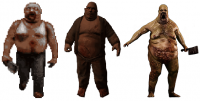
Various forms of fat zombie
- In Doom 3 there is a new type of zombie that does not appear in any other Doom game: the Fat Zombie, which is similar to the Bloated Butcher, except that it wears an open shirt, and attacks only with its fists. There is also a section of the game where the protagonist is riding on a Monorail eventually crashing it it in a manner reminiscent of Blood II: The Chosen. Some parts of the Delta Labs also share a similar feel to "C3L7: Research and Development", with new weapons and portal technologies being developed and various specimens from other worlds or dimensions being experimented on. CabalCo and the UAC share many similarities: a focus on R&D, caring about progress before safety, a willingness to risk their own members in scouting missions to hostile new dimensions (compare the scouts in hell to the scouts in Reality Beta), and sheer monopoly over many industries giving them no legal or moral obligations and control over dangerous advanced technology.
- The later Monolith Productions game F.E.A.R. features many levels similar to Blood II: The Chosen including a sewage treatment plant, corporate offices, and condemned tenements, with the game's soldier enemies also being similar to Fanatics. It also has something of a focus on using guns two at a time, with the player able to use the default pistols and, in the Xbox 360 version, a pair of larger machine pistols akimbo. The third-party stand-alone expansion pack Extraction Point also has similarities to the original Blood, featuring a haunted cathedral, funeral home, and hospital, as well as subway stations much like those in Blood II. Perseus Mandate features a trainyard.
- The Monolith developed sequel F.E.A.R. 2: Project Origin also features an interval set in a hospital and has the player move through subways, while also featuring a corporate laboratory with imprisoned test subjects similar to "C3L7: Research and Development" in Blood II.
- The Bloat, of Killing Floor, greatly resembles the Bloated Butcher: both are obese zombie-like foes that use meat cleavers and corrosive vomit to attack the player(s). However, the Bloat is nude and can be heard speaking actual phrases, compared to the fully-clothed Bloated Butcher, which can only moan incoherently at the player. Additionally, the Bloat has no ranged attacks like the Bloated Butcher - it cannot toss its meat cleaver or spit its vomit as a projectile - and it explodes on death from regular damage, showering its nearby foes in its bile.
- In Call of Duty: World at War, a minigame known as "Nazi Zombies", in the maps "Shi no Numa" and "Der Riese", contains a weapon known as "Wunderwaffe DG-2", which fires a bolt of electricity towards enemies. The file name for the DG-2 is apparently "Tesla", which is coincidentally a nod off to the Tesla Cannon. In addition to the two maps, an enemy known as the "hellhound" (a demonic dog that attacks with its fangs and claws or explodes on the player) is featured in the game; when injured or nearing the player, the hellhound suddenly catches on flames, indicating it will explode when killed or on contact - similar to the fire based attack of the Blood Hell Hound. World at War also contains weapons that appeared in the Blood series, such as the Sawed-Off Shotgun, Thompson Submachine Gun (which appears more like its military counterpart, though can be fitted with the drum magazine of the version in Blood), a ray gun, a combat knife and a type of timed explosive known as the "Monkey bomb".
- The logo of the Brazilian militia in Call of Duty: Modern Warfare 2 is a bloody hand-print, similar to the one on the boxart of Blood. Interestingly as well, one of only two shotguns in the game that can be used akimbo is a sawed-off double-barreled variety. Additionally, one of the available emblem layers in the sequel Black Ops also resembles the Blood boxart.
- Much of the Penumbra series takes place in an abandoned Arctic mine similar to the one found in "E2M6: The Cold Rush". The game also features the protagonist Philip facing off against giant spiders, much like those found in Blood. In Penumbra: Black Plague to solve a puzzle the player also must make a flame-thrower from an Aerosol Can and Zippo. The voice of the Tuurngait Hive Mind also sounds similar to that of The Ancient One through the Undead Chosen; Lani Minella, who voiced Ophelia and Gabriella, is credited for the voice of the Hive mind. Penumbra also features a scene where a person is lit on fire.
- The Trine 2 expansion pack Goblin Menace includes a level set inside a worm's stomach which plays rather similarly to E4M7: In The Flesh from Blood.
- Certain enemies in The Darkness II have been compared to the Fanatics in Blood II: The Chosen.
- The freeware first-person shooter LAB features multiple enemies with projectile vomit, similar to the Bloated Butcher. Unlike the Butcher however, their spew is capable of bouncing along the floor.
- The indie first person shooter Affliction Rescue opens with a level set in a hedge garden.
- The Doom official add-on entitled Base Ganymede ends in a level with winding biological interiors reminiscent of E4M7: In The Flesh.
- The replacements for the Golem from Heretic in Blasphemer are figures in grey robes similar to a Fanatic called Ghouls.
- The short lived 2013 indie sandbox first-person shooter Frozen Nightmare featured using a tommy gun in wintry environments. It later evolved into the space game Diversitas.
See Also[edit]
- Fan Media Category: for Blood works made by fans.
- References in Blood: for references to other media made inside of Blood.
